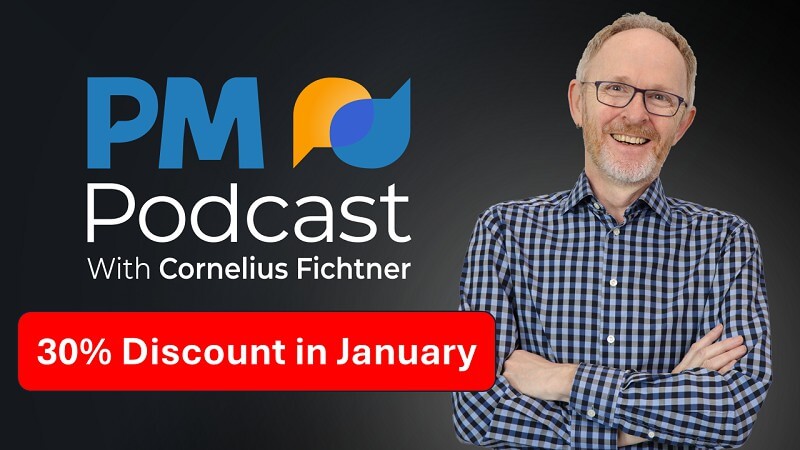Every project needs a plan! But where do you start? How do you know what to include and what is important to think about before the project work begins? And what are the likely challenges you’ll see when putting together a structured project plan?
On this page you'll find the answers to those questions and more! This is your one-stop guide to project planning.
We also have a range of expert podcast interviews with practitioners and thought leaders who can help you think strategically about what project planning means for your project.
Article Contents
- Featured Podcast: Every Project Leader Needs a Project Plan
- What is a Project Plan?
- Why is Project Planning Important?
- The 5 benefits of project planning
- When Do You Need a Project Plan?
- How to Write a Project Plan
- Project Plan Templates
- Project Management Plan Checklist
- PM Podcast Episodes on Project Planning
- Summary
Featured Podcast: Every Project Leader Needs a Project Plan
Listen now to this featured podcast on project plans.
In this featured podcast you learn why every project leader needs a plan, drawing on tips and lessons from Ron Black's book: Leadership - The Everyday Superhero's Action Guide to Plan and Deliver High-Stakes Projects. If you don't feel like a superhero right now, you will after listening to this episode!
In our discussion, Ron and Cornelius focus on introducing you to his "Super Power Points". These are poignant one-liners (i.e. "To finish faster, start a little slower") that he offers at the end of each chapter to summarize the message. We review each of the 15 points from the opening chapters and Ron gives us his insights and recommendations that show why even the best project leader needs a project plan. You'll pick up some great insights to support your planning process. Enjoy.

What is a Project Plan?
A project plan is a document which details how the project will be managed, delivered, monitored, controlled and closed down.
The project plan is a document that lays out everything the team needs to know about how the project will be managed. It’s normally made up of several sub-plans that cover quality, stakeholder engagement, team management, communication, risk, quality and cost management, and you might include other elements if your project environment calls for them. Essentially, include in your project management plan everything you need to document how the project will be managed and controlled going forward. A project overview template will help because it covers all the processes the team needs to follow so that everyone understands the steps to take.
Your project plan is a critical document. It sets out how you will execute the project and the processes and practices for running the project. It's basically your guidebook for doing the project management on this project, laying out how you as the project leader, and the team, will approach completing the work.
It is more than your list of tasks and dates – that list is what project managers normally refer to as a project schedule. The schedule is an important part of the plan, but it’s not the only part. The team decides which project methodology you will use, who needs to be involved and how you will handle things that might or do go wrong -- all that information goes into the plan.
Why is Project Planning Important?
Project planning is important because:
-
It confirms the project's objectives
-
It establishes the scope of the work
-
It helps manage expectations about how the work will be done
Project planning confirms the objectives
Planning is the process of working out how you are going to deliver the project with the team. Therefore it's really important to clarify exactly what you are supposed to be delivering. Planning conversations help confirm and clarify the project's objectives so everyone knows what they are supposed to be doing.
Project planning establishes scope
With your objectives clear, another reason why planning is important is because you get to have a conversation about what's in scope. And, conversely, what is out of scope. You'll use the scope management process to define exactly what the project is going to deliver and what hasn't made the cut.
Project planning manages expectations
Meeting as a team and having these preliminary conversations about how you will approach the work is also important for another reason: it makes sure everyone is clear on how the work will be managed. You are setting expectations about who is doing what, and how, right from the beginning. This can help reduce conflict later on and means the team share common expectations.
The 5 benefits of project planning
With around 11% of investment wasted due to poor project performance, it's important to consider what you can do to plan for success.
What is the most important part of the plan? It's that you have a clear objective about what is going to be done. It’s crucial that everyone has the same understanding about what is to be delivered, so the team can work together with a common goal.
There are many other needs for project planning including:
-
Understanding what resources are required to deliver the work and who will be accountable for what.
-
Working out how long it will take to deliver the work and how much it will cost.
-
Thinking about what problems might come up during the project so you can consider how to address them before they happen.
-
Considering how the team will work together.
-
Learning from past projects and using project plan examples from previous work to help plan your current initiative.
1
Understand the resources required
2
Work out the project's duration
3
Consider how to approach problems
4
Agree how the team will work together
5
Learn from past projects
When Do You Need a Project Plan?
The project planning phase happens at the start of the project. Preparing your project plan document is something you’ll do as the project gets started. You'll normally work with input from the project sponsor and the rest of the project team. You’ll need their support and agreement for many of the components of the plan, for example, who is going to do the work and how much it will cost.
Every project needs a plan, and the good news is that every other project in your organization should have had one. So you don't need to start from scratch. Find an example of a project work plan from a past project and use that to get started.
As a project manager, your technical skills take you far but they don’t take you far enough. When the project starts getting more and more complex, the leadership skills become more and more important.

How to Write a Project Plan
- Define the objectives
- Assemble the team
- Document your project scope
- Create the schedule
- Plan stakeholder management
- Agree your processes
- Be prepared to be flexible!
The project manager’s role is to produce the project plan, even though you will not personally have all the information required to populate it. You’ll need to work with your project team, facilitating meetings and collaborating on the final document until you’ve got something you can work from.
Here’s a step-by-step guide to the project planning process.
Define the objectives
What is it that you are trying to do? The first of the project planning process steps answers this question. At this point you are looking for key success criteria, high level deliverables and overall goals. We’ll get to planning the tasks in detail a little later.
You can often find information for the project plan outline in the business case, or get it from your project sponsor if you aren’t clear on the goals.
Assemble the team
Document your project scope
Now we come to working out exactly what tasks are required. You can create a project scope document, requirement documentation and a Work Breakdown Structure, or any combination of those things that will help everyone on the team understand the full scope of the work. This is where your skills in how to facilitate productive project planning meetings will be really useful! Remember, curiosity improves project management so keep asking questions! Get the group together and talk about what project planning questions you need answers to in order to establish what tasks are required.
For each task, estimate how long it will take, how much it will cost and assign someone to take responsibility for it.
Create the schedule
The project planning process is not the time to create a very detailed project schedule, but you do need an idea of how long the project will take, key dates and milestones.
Take your list of tasks and work out the order in which they need to be completed. For example, you can’t paint the walls of the new office before the building has been constructed. Your subject matter experts will be important here: they should advise on the order for their tasks. The links between tasks that determine the order of work are called dependencies.
Once you’ve got high-level information about how long tasks will take and what order they need to happen in, you can go ahead and create an outline project schedule or timeline. Use a project management software tool to make things easier. You’ll end up with a visual representation of your project work in a format everyone can see and understand.
Plan stakeholder management
Some of your stakeholders will be responsible for project tasks, so add their details into the project schedule. This step helps you see who has a lot of work on at any one moment in time. You don’t want your resources to be overloaded, so you might need to make adjustments to the schedule to allow for their other commitments. Remember, many project stakeholders are involved in multiple projects so they might not be available to you on a full-time basis.
Agree your processes
The project schedule is an important part of the plan, but you’ll also want to look at how the team will manage other project management processes. Think about how you will ensure the budget is managed efficiently, how you will track and measure quality, and how you will cope with risk and changes. Take the time to consider how you are going to address those important project management processes and document how you will work together.
Be prepared to be flexible!
The main purpose of project plans is to document what is going to happen so everyone knows what is expected of them. But plans change. As the Agile Manifesto says, responding to change is valued. Experienced project managers will tell you that as soon as you start the work you’ll find you need to make adjustments.
If you start the project and realize you need a different approach to managing project risk, for example, then change your practices and update the plan to reflect your new way of working. Just remember to let the rest of the team know that things have changed so they reference the right document. If the changes are significant, you might need to go through the project document approval process again.
Be prepared to be flexible and make whatever changes you need to so the team stays on track.
Project Plan Templates
Even if you don't have a plan from an old project to start from, you can still speed up the process by using a document template. Templates include all the relevant headings and topics that should go in the plan. Many templates even have sample text in them so you can see an example of a simple project plan to give you ideas about how to document your own work.
We have collated our recommended project plan templates and we even did a podcast episode about them! In the video podcast, you can see the sites we recommend and take a peek inside a couple of template examples. Watch the episode about project plan templates.
You can create plans in any kind of software. If your company doesn't have a standard for what to use, look for a template that will help with how to create a project plan in Excel or Word.
Project Management Plan Checklist
Here’s a quick-start project management plan checklist so you can make sure all the important elements are captured in your plan.
-
Do you know your project’s goals?
-
Do you understand the project planning steps?
-
Have you held a project planning meeting?
-
Do you have a project planning template?
-
Have you completed a work breakdown structure or scope document?
-
Have you secured the right resources to do the work?
-
Have you estimated task durations?
-
Have you mapped task dependencies?
-
Have you assigned resources to tasks?
-
Have you checked to see no one has too much (or too little) work to do on any day?
-
Have you got a plan for what happens when things change?
-
Has your plan been approved by the team and the project sponsor?
-
Have you put your schedule in a project planning tool?
Planning is a collaborative effort to ensure the project runs smoothly. A great plan will start your project off in the right direction!
PM Podcast Episodes on Project Planning
How to Plan Your Project Using Index Cards

Planning and Controlling Megaprojects

Advanced Product Quality Planning

How to Facilitate a Project Planning Meeting

Summary
A good project plan saves you a lot of time because it removes uncertainty and provides a structure to follow for the whole project life cycle. It also removes a lot of the debate and discussion about whether the project has met quality criteria or how something should be done – because you’ve already documented and agreed what needs to happen.
Project planning can take time, but it’s time well spent. You are ultimately helping the team be more successful by setting them up for success. Strong planning results in a stronger outcome and fewer headaches along the way.
